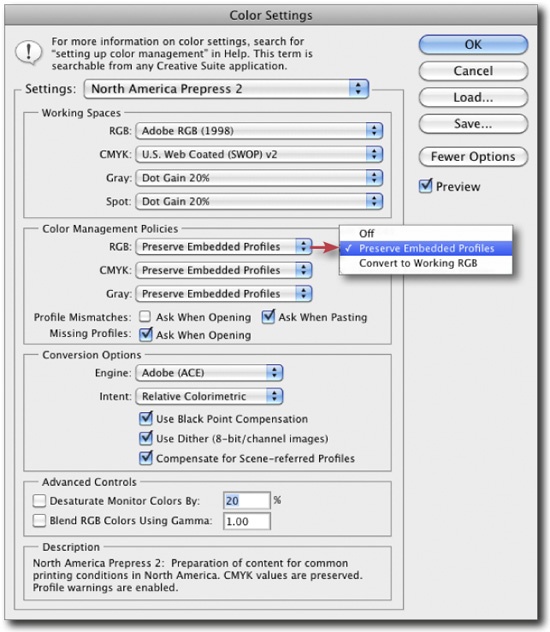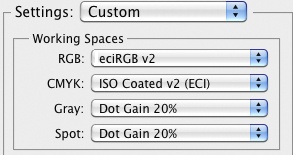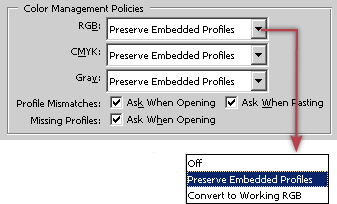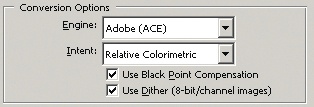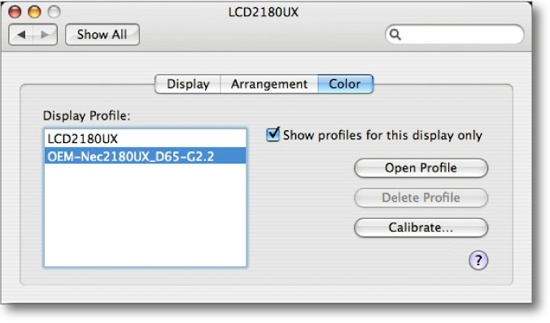Before you start work with Photoshop, you will need to set up your personal color management preferences. All Adobe Creative Suite elements use similar methods for making color settings, and the CS2 (and higher) versions allow you to make color settings centrally using Bridge.
Photoshop has one of the most sophisticated color management systems currently available, with a wide range of options and parameter settings. Select Edit ▸ Color Settings to open the color settings dialog. Figure 3-24 shows the Photoshop color settings we use.
Note
![]() In Mac OS and CS1 (or earlier) versions, the Color Settings dialog can be found in the Photoshop Preferences dialog.
In Mac OS and CS1 (or earlier) versions, the Color Settings dialog can be found in the Photoshop Preferences dialog.
Here is where you define your default working spaces for the various color modes (RGB, CMYK, Grayscale, and Spot Color). The RGB working space is the most important one for photographers.[51] The CMYK working space is only relevant for converting RGB images to CMYK. The profile selected here is used as the destination color space. If your print shop doesn’t advise you otherwise, U.S. Web-Coated (SWOP) v2 is the best CYMK option to use.
Note
We ignore the settings for CMYK and Gray here, as we only cover RGB color setup in our workflow. If you live in Europe, your CMYK setting should be Euroscale Coated v2 (ECI). If you are preparing images for pre-press use, select eciRGB v2 as your default RGB color space, making your settings look like those in Figure 3-25.
Photoshop’s default value is Dot Gain 20, which is usually appropriate for working with grayscale images. If your print shop gives you different values, use them. The same is true for the spot color setting.
Color Management Policies define the default action that Photoshop takes when you open an image or paste pixels into an opened image that has no embedded profile or a different color space from your current working space. You can make this setting for RGB, CMYK, and grayscale images.
In most cases, Preserve Embedded Profiles is the best choice. The only reasonable alternative is Convert to Working Space. Selecting Off rarely makes sense in a color-managed workflow. If you choose Off, color management will still take place, but it will treat the image colors as if they come from the current working space. With Off, no profile is embedded when the image is saved.
The checkboxes define Photoshop’s default actions when a mismatch is found. For unchecked options, Photoshop will apply the action selected for the current color mode, and for checked options, Photoshop prompts the user for input.
Use the Engine drop-down menu to select the color engine (color management module) you want to use. We prefer Adobe (ACE) because it is simply better than ICM (Microsoft Windows) or ColorSync (Mac OS) and is operating system-independent.
Use either the Relative Colorimetric or Perceptual intent for photo editing (Mapping Color Spaces).
Use Black Point Compensation adapts the black point of converted images to that of the target color space and ensures that the entire destination space is used.
Note
![]() If the profile supplier (an inkjet paper manufacturer, for instance) states otherwise, follow the given guidelines! Some manufacturers recommend that you uncheck Use Black Point Compensation and use the Perceptual rendering intent.
If the profile supplier (an inkjet paper manufacturer, for instance) states otherwise, follow the given guidelines! Some manufacturers recommend that you uncheck Use Black Point Compensation and use the Perceptual rendering intent.
The Use Dither (8-bit/channel images) option is only useful if you are converting 8-bit images from one color space to another. If the source color is not present in the destination space, Photoshop will try to simulate the source color using dithering. This may improve the visual color accuracy, but it often introduces slight random image noise. You should experiment on your own to find the optimum setting for dithering.
Leave these settings unchecked as shown in Figure 3-28.
Photoshop is not particularly intuitive when it comes to finding the current monitor profile. The following methods are the simplest that we know:
Windows XP: Right-click on the desktop and select Properties. Select the Settings tab in the dialog that appears and click the Advanced button. Selecting the Color Management tab then displays a dialog containing all installed monitor profiles. The currently active profile is highlighted (see Figure 3-29 for the Windows XP version).
Here, you can add additional monitor profiles, delete installed ones, and change the default profile. You may have to restart your image processing program to apply any changes you make.
If you are running Windows XP and have MS Color Control Panel installed ([97]), you can use the Displays option in the WinColor Devices tab to view the profile associated with your display.
Windows Vista, Windows 7: Activate Control Panel Color Management, select tab Devices, and choose Display in the Device menu. Windows will show a dialog similar to that of Figure 3-29, where you can select your monitor’s profile. Also use this Control Panel to install and uninstall color profiles.
Mac OS X: Open System Preferences by clicking the ![]() icon in the dock. Select Displays and activate the Color tab. The dialog will list all installed monitor profiles and highlight the currently active one (Figure 3-30).
icon in the dock. Select Displays and activate the Color tab. The dialog will list all installed monitor profiles and highlight the currently active one (Figure 3-30).

